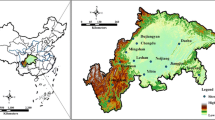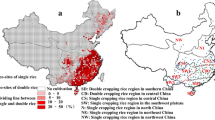Abstract
Rice is the staple food in China, and the country’s enlarging population puts increasing pressure on its rice production as well as on that of the world. In this study, we estimate the impact of climate change, CO2 fertilization, crop adaptation and the interactions of these three factors on the rice yields of China using model simulation with four hypothetical scenarios. According to the results of the model simulation, the rice yields without CO2 fertilization are predicted to decrease by 3.3 % in the 2040s. Considering a constant rice-growing season (GS), the rice yields are predicted to increase by 3.2 %. When the effect of CO2 fertilization is integrated into the Agro-C model, the expected rice yields increase by 20.9 %. When constant GS and CO2 fertilization are both integrated into the model, the predicted rice yield increases by 28.6 %. In summary, the rice yields in China are predicted to decrease in the 2040s by 0.22 t/ha due to climate change, to increase by 0.44 t/ha due to a constant GS and to increase by 1.65 t/ha due to CO2 fertilization. The benefits of crop adaptation would completely offset the negative impact of climate change. In the future, the most of the positive effects of climate change are expected to occur in northeastern and northwestern China, and the expansion of rice cultivation in northeastern China should further enhance the stability of rice production in China.


Similar content being viewed by others
References
Ainsworth EA (2008) Rice production in a changing climate: a meta-analysis of responses to elevated carbon dioxide and elevated ozone concentration. Glob Change Biol 14:1642–1650
Bannayan M, Mansoori H, Rezaei EE (2013) Estimating climate change, CO (2) and technology development effects on wheat yield in northeast Iran. Int. J. Biometeorol.
Beldring S, Engen-Skaugen T, FØRland EJ, Roald LA (2008) Climate change impacts on hydrological processes in Norway based on two methods for transferring regional climate model results to meteorological station sites. Tellus A 60:439–450
Challinor AJ, Ewert F, Arnold S, Simelton E, Fraser E (2009) Crops and climate change: progress, trends, and challenges in simulating impacts and informing adaptation. J Exp Bot 60:2775–2789
Chavas DR, Izaurralde RC, Thomson AM, Gao X (2009) Long-term climate change impacts on agricultural productivity in eastern China. Agr For Meteorol 149:1118–1128
Chen C, Qian C, Deng A, Zhang W (2012) Progressive and active adaptations of cropping system to climate change in Northeast China. Eur J Agron 38:94–103
China National Rice Research Institute (1988) Regional zonation of rice cropping in China (in Chinese with English summary. Zhejiang Publishing Press of Science and Technology, Hangzhou
Deryng D, Sacks WJ, Barford CC, Ramankutty N (2011) Simulating the effects of climate and agricultural management practices on global crop yield. Global Biogeochem. Cy. 25:GB2006
Ewert F (2012) Adaptation: opportunities in climate change? Nat Clim Chang 2:153–154
FAOSTAT (2013) Statistics database. Available on http://faostat.fao.org
Gammulla CG, Pascovici D, Atwell BJ, Haynes PA (2010) Differential metabolic response of cultured rice (Oryza sativa) cells exposed to high- and low-temperature stress. Proteomics 10:3001–3019
Gervois S, Ciais P, de Noblet-Ducoudre’ N, Brisson N, Vuichard N, Viovy N (2008) Carbon and water balance of European croplands throughout the 20th century. Global Biogeochem. Cy. 22:GB2022, doi:2010.1029/2007GB003018
Hay LE, Wilby RL, Leavesley GH (2000) A comparision of delta change and downscaled GCM scenarios for three mountainous basins in the United States. J Am Water Resour Assoc 36:387–397
Huang Y, Zhang W, Sun W, Zheng X (2007) Net primary production of Chinese croplands from 1950 to 1999. Ecol Appl 17:692–701
Huang Y, Yu Y, Zhang W, Sun W, Liu S, Jiang J, Wu J, Yu W, Wang Y, Yang Z (2009) Agro-C: a biogeophysical model for simulating the carbon budget of agroecosystems. Agr For Meteorol 149:106–129
Kim HY, Ko J, Kang S, Tenhunen J (2013) Impacts of climate change on paddy rice yield in a temperate climate. Glob Change Biol 19:548–562
Lanning SB, Siebenmorgen TJ, Counce PA, Ambardekar AA, Mauromoustakos A (2011) Extreme nighttime air temperatures in 2010 impact rice chalkiness and milling quality. Field Crops Res 124:132–136
Li Q, Dong W, Li W, Gao X, Jones P, Kennedy J, Parker D (2010) Assessment of the uncertainties in temperature change in China during the last century. Chin Sci Bull 55:1974–1982
Lin E, Xiong W, Ju H, Xu Y, Li Y, Bai L, Xie L (2005) Climate change impacts on crop yield and quality with CO2 fertilization in China. Philos T Roy Soc B 360:2149–2154
Liu Y, Wang E, Yang X, Wang J (2010) Contributions of climatic and crop varietal changes to crop production in the North China Plain, since 1980s. Glob Change Biol 16:2287–2299
Liu L, Wang E, Zhu Y, Tang L (2012) Contrasting effects of warming and autonomous breeding on single-rice productivity in China. Agr Ecosyst Environ 149:20–29
Long SP (2012) Virtual special issue on food security—greater than anticipated impacts of near-term global atmospheric change on rice and wheat. Glob Change Biol 18:1489–1490
Mao CX (2010) Developing indica-type hybrid rice in China. In: Xie F, Hardy B (eds) Accelerating hybrid rice development. International Rice Research Institute, Los Baños (Philippines), pp 581–592
Masutomi Y, Takahashi K, Harasawa H, Matsuoka Y (2009) Impact assessment of climate change on rice production in Asia in comprehensive consideration of process/parameter uncertainty in general circulation models. Agr Ecosyst Environ 131:281–291
Nakicenovic N, Alcamo J, Davis G, de Vries B, Fenhann J, Gaffin S, Gregory K, Grubler A, Jung TY, Kram T (2000) Special report on emissions scenarios: a special report of Working Group III of the Intergovernmental Panel on Climate Change. Pacific Northwest National Laboratory, Richland, WA (US), Environmental Molecular Sciences Laboratory (US)
National Bureau of Statistics of China (2013) Statistics database. Available on http://219.235.129.58/welcome.do
Peng X (2011) China’s demographic history and future challenges. Science 333:581–587
Peng S, Laza R, Visperas R, Sanico A, Cassman KG, Khush G (2000) Grain yield of rice cultivars and lines developed in the Philippines since 1966. Crop Sci 40:307–314
Peng S, Khush GS, Virk P, Tang Q, Zou Y (2008) Progress in ideotype breeding to increase rice yield potential. Field Crops Res 108:32–38
Piao S, Ciais P, Huang Y, Shen Z, Peng S, Li J, Zhou L, Liu H, Ma Y, Ding Y (2010) The impacts of climate change on water resources and agriculture in China. Nature 467:43–51
Prudhomme C, Reynard N, Crooks S (2002) Downscaling of global climate models for flood frequency analysis: where are we now? Hydrol Process 16:1137–1150
Rosenzweig MR, Binswanger HP (1992) Wealth, weather risk, and the composition and profitability of agricultural investments. World Bank Publications
Shrestha S, Asch F, Brueck H, Giese M, Dusserre J, Ramanantsoanirina A (2013) Phenological responses of upland rice grown along an altitudinal gradient. Environ Exp Bot 89:1–10
Slayton T (2009) Rice crisis forensics: how Asian governments carelessly set the world rice market on fire. Center for Global Development Working Paper 163
Tao F, Yokozawa M, Liu J, Zhang Z (2008) Climate-crop yield relationships at provincial scales in China and the impacts of recent climate trends. Climate Res 38:83–94
Thornton PE, Running SW, White MA (1997) Generating surfaces of daily meteorological variables over large regions of complex terrain. J Hydrol 190:214–251
Thornton PE, Hasenauer H, White MA (2000) Simultaneous estimation of daily solar radiation and humidity from observed temperature and precipitation: an application over complex terrain in Austria. Agr For Meteorol 104:255–271
Wan Y, Lin E, Xiong W, Ye L, Guo L (2011) Modeling the impact of climate change on soil organic carbon stock in upland soils in the 21st century in China. Agr Ecosyst Environ 141:23–31
Xiong W, Conway D, Lin E, Holman I (2009a) Potential impacts of climate change and climate variability on China’s rice yield and production. Clim Res 40:23–35
Xiong W, Conway D, Lin E, Xu Y, Ju H, Jiang J, Holmam I, Li Y (2009b) Future cereal production in China: the interaction of climate change, water availability and socio-economic scenarios. Glob Environ Chang 19:34–44
Xiong W, Holman I, Lin E, Conway D, Li Y, Wu W (2012) Untangling relative contributions of recent climate and CO2 trends to national cereal production in China. Environ Res Lett 7:044014
Yang X, Liu Z, Chen F (2011) The possible effect of climate warming on northern limits of cropping system and crop yield in China. Sci Agric Sin 10:585–594
Yu D, Shi X, Wang H, Sun W, Chen J, Liu Q, Zhao Y (2007) Regional patterns of soil organic carbon stocks in China. J Environ Manag 85:680–689
Yu Y, Huang Y, Zhang W (2012a) Changes in rice yields in China since 1980 associated with cultivar improvement, climate and crop management. Field Crops Res 136:65–75
Yu Y, Huang Y, Zhang W (2012b) Modeling soil organic carbon change in croplands of China, 1980–2009. Glob Planet Chang 82–83:115–128
Yu Y, Huang Y, Zhang W (2013) Projected changes in soil organic carbon stocks of China’s croplandsunder different agricultural managements, 2011–2050. Agric Ecosyst Environ 178:109–120
Zhang F, Wang D, Qiu B (1987) Agro-phenological atlas of China (in Chinese with English content). Science Press, Beijing
Zhang W, Huang Y, Sun W, Yu Y (2007) Simulating crop net primary production in China from 2000 to 2050 by linking the Crop-C model with a FGOALS’s model climate change scenario. Adv Atmos Sci 24:845–854
Zhou Y, Li N, Dong G, Wu W (2013) Impact assessment of recent climate change on rice yields in the Heilongjiang Reclamation Area of Northeast China. J. Sci. Food Agric
Acknowledgments
This work was jointly supported by the Ministry of Science and Technology of China (Grant No. 2012CB417106 & 2010CB950604), the CAS Strategic Priority Research Program (Grant No. XDA05050507) and the National Natural Science Foundation of China (Grant No. 41321064).
Author information
Authors and Affiliations
Corresponding author
Electronic supplementary material
Below is the link to the electronic supplementary material.
Table S1
Description of Agro-Ecological Zones in China (DOCX 26 kb)
Fig S2
The dynamics of climatic factors in different climatic scenarios from 2011 to 2050 (DOCX 145 kb)
Fig. S3
Temporal changes in the projected rice yields in various management and climate change scenarios in the next four decades. The baseline value is the average rice yield in S0 in the 2000s. The expected yields of (a) early rice in A2; (b) late rice in A2; (c) single rice in A2; (d) area-weighted rice in A2; (e) early rice in B2; (f) late rice in B2; (g) single rice in B2; and (h) area-weighted rice in B2 are based on the cultivated areas of each type of rice in 2010 (DOCX 515 kb)
Fig. S4
Temporal changes in the projected rice yields in various management scenarios in the next four decades. The baseline value is the average rice yield in S0 in the 2000s. The expected yields of (a) early rice; (b) late rice; (c) single rice; and (d) area-weighted rice are based on the cultivated areas of each type of rice in 2010 (DOCX 134 kb)
Fig. S5
Predicted rice yield changes and variations in the next four decades in different scenarios. The error bars represent the standard deviation of the yield in a given scenario for a given decade. The expected yields of (a) early rice; (b) late rice; (c) single rice; and (d) area-weighted rice are based on the cultivated areas of each type of rice in 2010 (DOCX 92 kb)
Fig. S6
Reduced growth duration in constant thermal time scenarios (S1 and S3) compared with that of the baseline scenario (S0). VG is the vegetative growth phase (from transplanting to heading), and RG is the reproductive growth phase (from heading to harvesting) (DOCX 579 kb)
Rights and permissions
About this article
Cite this article
Yu, Y., Zhang, W. & Huang, Y. Impact assessment of climate change, carbon dioxide fertilization and constant growing season on rice yields in China. Climatic Change 124, 763–775 (2014). https://doi.org/10.1007/s10584-014-1129-9
Received:
Accepted:
Published:
Issue Date:
DOI: https://doi.org/10.1007/s10584-014-1129-9




